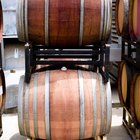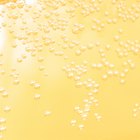
Cabernet sauvignon, a still wine made from red grapes, is often used in cooking. Some classic dishes -- beef bourguignon and coq au vin, for example -- get their distinctive flavor personality from cabernet sauvignon. Marsala, a fortified wine made from white grapes, is the ingredient behind other classics, such as veal and chicken Marsala. If you find you're out of Marsala, cabernet sauvignon often makes a suitable substitute.
Three Kinds of Wine
Wine is produced in three ways, each resulting in a different kind of wine -- sparkling, still and fortified. Sparkling wines are the bubbly stuff such as Champagne, spumante and cava. Still wines, such as cabernet sauvignon, chardonnay and pinot noir, have no bubbles and are the most popular. Fortified wines, such as Marsala and port, are still wines that have had brandy or another distilled spirit added to it; the addition of the distilled spirit stabilizes the wine and gives it a longer shelf life.
Flavor Differences
Despite the taste differences between Marsala and cabernet sauvignon, in a pinch, the cab will add a comparable wine-flavored dimension to your dishes.
Marsala, made from white grapes grown in the Italian region of the same name, can hold its own with a bold cabernet, thanks to the addition of brandy. Marsala comes in three styles -- secco, which is dry; semisecco, or medium dry and sweet dolce. Use dolce Marsala in dessert dishes and the other two for savory dishes.
Black currant is the predominant flavor characteristic of cabernet sauvignon, bringing a fruity fresh flavor to any dish. Astringency is also noticeable in cabernet although this flavor component mellows as the wine ages.
Alcohol Content
All still wines, including cabernet sauvignon, are about 11 to 13 percent alcohol. The exact percentage will vary a bit among varietals, vintners and vintages but not much. Once the alcohol content reaches this percentage, the yeast in the wine dies and fermentation, which generates alcohol production, stops. When brandy is added to Marsala wine, alcohol content increases. Fortified wines, including Marsala, usually range between 15 and 22 percent alcohol. Because most of the alcohol cooks off when added to dishes, the differences in alcohol content are not an issue. Some of the alcohol may linger in the dish, but it won't be a significant amount.
Tips for Cooking Success
Just like Marsala, cabernet sauvignon can be used to deglaze a pan. When substituting cabernet for Marsala in a dish that requires a long cooking time, add cabernet sauvignon early so the fruity flavor and astringency will mellow while cooking even if the recipe calls for adding Marsala toward the end of the cook time. Use cabernet sauvignon only when its dark color will not discolor the other ingredients in the recipe. Use any remaining cabernet sauvignon within a day or two of opening the bottle.
Related Articles

Brandy vs. Whiskey

Can I Make Sangria From White Zinfandel?

Substitutes For Tequila

What Is the Primary Difference Between ...

List of the Different Types of Champagne

Sauterne Wine Substitute

What Is the Difference Between Wine & ...

How to Cook With Rice Wine

How to Store Cognac

Qualities of a Good Wine

Examples of Dry Beers

Can You Substitute Rum for Brandy?

Wines to Serve With Cajun or Creole Food

What Wine Pairs With Chicken Alfredo?

What Does VSOP Mean?

Red Wines That Need to Be Chilled

How Much Is a Single Serving Size of a ...

What Wine Do You Pair With Chinese ...

How Long Should a Wine Collector Keep a ...

What Kind of Alcohol Is Good to Cook ...
References
Resources
Writer Bio
Sandy Hemphill graduated with honors from Western Culinary Institute, Portland, Oregon, in 1997. She's published a cookbook ("Texas to the Bone") and has a series of cookbooks in development. She writes a web page devoted to cocktails. After seven years of copywriting, she founded iRoar.org, for internet marketing.
Photo Credits
Zedcor Wholly Owned/PhotoObjects.net/Getty Images